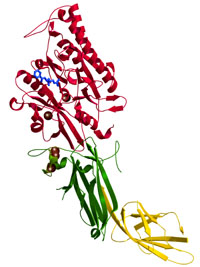 |
当研究室は、細胞内で起こる重要なイベントに関与するタンパク質群を対象に、それら蛋白質の立体構造で決定し、生体高分子間の多元的な相互作用に基づく機能発現機構を物理化学的な手法によって解析し、分子認識や制御機構といった細胞で起こる基本的なプロセスを構造生物学的な見地から明らかにすることを目的にしている。対象としているタンパク質は、主にヒト、植物、酵母由来のタンパク質で、情報伝達に関与するタンパク質やDNAの転写・複製・修復・組換に関与するタンパク質であり、それらは疾患に関与している物も少なくない。主な研究手法はX線や中性子線を用いた結晶構造解析法、溶液散乱法および核磁気共鳴法(NMR)であり、これらの手法を相補的に用いる。結晶構造解析法で得られる原子レベルの詳細な高次構造や分子間の多元的相互作用とともに、溶液散乱法を用いてリガンド結合に伴う高次構造変化の動的解析や非天然状態の動的挙動を解析する。また、NMRから得られる構造情報を組み合わせて、生体超分子複合体の構造と機能との関連をより詳細に明らかにすることを目指している。疾患関連タンパク質については、抗体医薬等の薬剤開発を目指した研究を進めている。
右の図は、当研究室で最近決定された、ヒト由来ペプチジルアルギニンデイミナーゼ4(PAD4)のX線結晶構造である。この研究成果はNature
Structure and Molecular Biology誌に掲載された。PAD4は関節リウマチに関与するタンパク質のであり、得られた立体構造を基に、関節リウマチの治療を目指した阻害剤開発を進めている。
X-ray or neutron diffraction (scattering) analysis of biologically
important systems such as DNA transcription / recombination /
repair / replication / translation and intracellular signal transduction
is of particular importance to elucidate the structure-function
relationship of the biological systems in living cells. Our ultimate
goal is to understand the protein-protein, protein-nucleic acid
or protein-lipid interactions from the high resolution crystal
structure analysis and the time-resolved solution scattering analysis,
and to establish general principles for architectures of biological
supramolecular complexes to describe the physical chemistry of
these cellular functions. |

PAD4のX線結晶構造 (2004) |